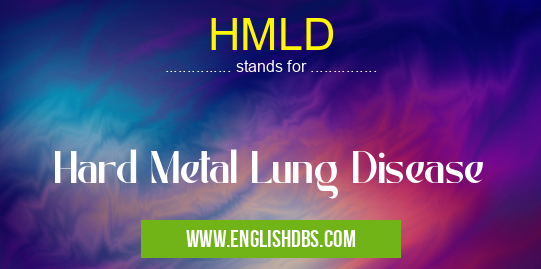What does HMLD mean in DISEASES
Hard Metal Lung Disease (HMLD) is an occupational lung disorder that affects those who have been exposed to metal particles in the workplace. HMLD typically occurs when workers inhale air that contains metal dust, which can cause chronic inflammation and scarring of the lung tissues over time. This is a serious condition that can lead to breathing difficulties, respiratory failure, and other life-threatening illnesses. In order to protect workers from this potentially dangerous condition, employers must take steps to reduce or eliminate exposure to these substances in the workplace.

HMLD meaning in Diseases in Medical
HMLD mostly used in an acronym Diseases in Category Medical that means Hard Metal Lung Disease
Shorthand: HMLD,
Full Form: Hard Metal Lung Disease
For more information of "Hard Metal Lung Disease", see the section below.
Health Risks of Hard Metal Lung Disease
Hard metal lung disease is caused by long-term exposure to metallic dusts such as cobalt, manganese, aluminum, chromium, and nickel. These metals can irritate and damage the lungs if they are present in high concentrations for prolonged periods of time. The most common symptoms of HMLD are wheezing, coughing up blood, chest tightness, shortness of breath and fatigue. In extreme cases, it can lead to respiratory failure or even death. Long-term conditions such as emphysema may also develop over time due to hard metal lung disease.
Prevention & Treatment
The best way to avoid hard metal lung disease is by limiting exposure to airborne metals at work through the use of appropriate protective equipment and ventilation systems. Employers should also implement strict safety guidelines and provide workers with periodic medical examinations so any possible exposures can be quickly identified and treated before they cause harm. Those diagnosed with HMLD should also seek prompt medical attention as soon as symptoms begin in order to minimize any potential long-term effects. Treatment options include inhalers for managing wheezing symptoms and breathing exercises for strengthening weakened muscles caused by the illness.
Essential Questions and Answers on Hard Metal Lung Disease in "MEDICAL»DISEASES"
What is Hard Metal Lung Disease (HMLD)?
Hard Metal Lung Disease (HMLD) is a rare form of pneumoconiosis caused by exposure to hard metal particles such as cobalt, tungsten, or chromium. It can cause pulmonary fibrosis and respiratory disability.
What are the symptoms of HMLD?
The symptoms of HMLD can vary depending on the amount and type of exposure to the hard metal particles. Common symptoms include shortness of breath, coughing, wheezing and chest pain.
Who is at risk for developing HMLD?
People who work with metals or in industries such as jewelry-making and welding are at higher risk for developing HMLD than those who don't work with these materials.
How is HMLD diagnosed?
HMLD can be diagnosed through a physical examination, X-rays, chest scans and lung function tests. Blood tests may also be conducted to identify levels of specific metals in the body which could indicate a diagnosis for HMLD.
How is HMLD treated?
Treatment for HMLD will depend on the severity of the disease but may include medication to help reduce inflammation or antibiotics if an infection has developed. Oxygen therapy may also be prescribed if breathing becomes difficult.
Are there any lifestyle changes that can help manage HMLD?
People with HMLD should avoid further exposure to metallic dusts and fumes, exercise regularly and quit smoking if they smoke. Eating a balanced diet high in fruits and vegetables can also help reduce inflammation associated with this condition.
Is there a cure for HMLD?
Unfortunately, there is no known cure for this condition however management techniques such as avoiding further contact with metals and following proper medical treatment programs can help limit the progression of the disease.
Final Words:
Hard Metal Lung Disease (HMLD) is a serious occupational health issue that has serious implications on worker safety and health outcomes. If left untreated it could gradually cause more damage leading to permanent disability or even death in some cases if not properly managed early on in diagnosis. For this reason employers must take steps at all times to reduce or even eliminate any potential exposure risks, while workers need regular medical examinations for early detection of any signs of complications from the illness.
